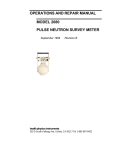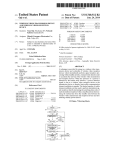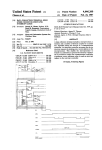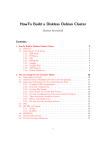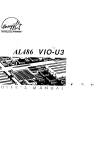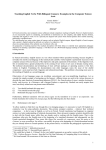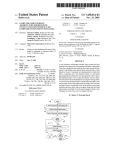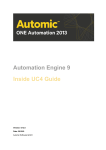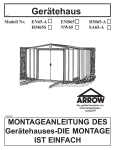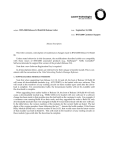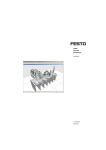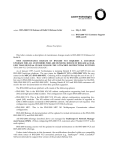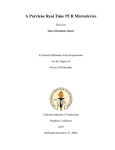Download Method and system for providing high performance Web browser
Transcript
US006397253B1
(12) United States Patent
(10) Patent N0.:
(45) Date of Patent:
Quinlan et al.
(54)
May 28, 2002
METHOD AND SYSTEM FOR PROVIDING
“Guaranteed Delivery”, by Barry Nance, Byte, Aug. 1997,
HIGH PERFORMANCE WEB BROWSER
AND SERVER COMMUNICATIONS
pp. 77—78, 80, 82 & 84.
“Web Components”, by Dick Pountain & John Montgomery,
Byte, Aug. 1997, pp. 56—60, 62, 64, 66 & 68.
“Transaction Processing On The Web”, by David MattheWs
& Wayne Worden, Group Bull Technical Update, vol. 6, No.
3, Copyright Bull HN Information Systems Inc. & Bull SA,
(75) Inventors: Cian M. Quinlan; Michael L. Giroux,
both of Phoenix, AZ (US)
(73) Assignee: Bull HN Information Systems Inc.,
Billerica, MA (US)
(*)
US 6,397,253 B1
Notice:
1996, pp. 11—18.
“Tools & Utilities, Transaction Screen Management, System
8, TSM8 Reference Manual, GCOS 8”, Publication No. 67
Subject to any disclaimer, the term of this
patent is extended or adjusted under 35
A2 ED42 Rev 02, Copyright 1996 Bull HN Information
U.S.C. 154(b) by 0 days.
Systems Inc.
“Transaction Processing, TPFF System, SoftWare Release
Bulletin, SoftWare Release 8F01.0, Update 5, GCOS 8”,
Publication No. 67A2 SA65 Rev 05, Copyright 1985, 1993
(21) Appl. No.: 09/166,877
(22) Filed:
Oct. 6, 1998
Bull SA. & Bull HN Information Systems Inc.
(51)
Int. Cl.7 .............................................. .. G06F 15/16
(52)
(58)
US. Cl. ...................... .. 709/227; 709/217; 709/203
Field of Search ............................... .. 709/203, 217,
* cited by examiner
709/218, 227, 228, 229, 219, 224
(56)
Primary Examiner—David Wiley
Assistant Examiner—Philip B. Tran
(74) Attorney, Agent, or Firm—Faith F. Driscoll; John S.
Solakian
References Cited
U.S. PATENT DOCUMENTS
(57)
5,754,772 A
5/1998 Leaf
5,754,774 A
5/1998 Bittinger
ABSTRACT
A client system utilizes a standard broWser component and
5,754,830 A
*
5/1998 Butts et a1. ............... .. 709/227
5,778,372 A
*
7/1998 Cordell et a1. .
709/218
5,784,562 A *
5,796,393 A *
7/1998 Diener
8/1998 MacNaughton et a1.
709/217
709/203
5,857,201 A
1/1999 Wright, Jr. et a1. ....... .. 707/104
connections and reuse of existing session connections as a
1/1999 Bittinger
function of the coding of the universal resource locators
*
5,859,971 A
5,867,661
5,898,835
5,918,009
5,961,601
6,035,324
A
A
A
A
A
* 2/1999 Bittinger et a1. .......... ..
* 4/1999 Truong ..................... ..
* 6/1999 Gehani et a1. ............ ..
* 10/1999 Iyengar ...... ..
* 3/2000 Chang et a1. ...... ..
6,035,332 A *
6,148,340 A
3/2000 Ingrassia, Jr. et a1.
a transaction protocol gateWay (TPG) component that opera
tively couples to the standard broWser component. The
broWser component initiates the utilization of neW session
709/227
709/217
709/219
709/229
709/203
(URLs) contained in each issued request. Each URL is
passed to the TPG component that examines a context ?eld
included Within the URL. If the context ?eld has been set to
a ?rst value, the TPG component opens a neW session
connection to the server system and records the session
709/224
connection information in a persistent session table (PST)
component maintained by the TPG component. If the con
* 11/2000 Bittinger et a1. .......... .. 709/224
OTHER PUBLICATIONS
text ?eld has been set to a second value, then the TPG
“HoW to Put Mainframes on the Web”, by Salvatore Sala
mone, Byte, Jun. 1996, pp. 53—54.
component obtains the session connection information in the
PST component for the established session connection and
“The Last Word—Selecting Java App Servers”, by Dan
Kara, Object Magazine, Jun. 1998, pp. 72 and 70—71.
passes the data from the broWser component to the server
system over the existing persistent session connection.
“Unlocking the Mainframe”, by Martin Rennhackkamp,
55 Claims, 8 Drawing Sheets
DBMS, Jun. 1997, pp. 55—56 & 58—59.
|
|
|
HEILIBBARV V
BASE ROUTINE
l
1
PERSISTENT
NDN-PERSISTENT
conmzcnon
L if‘
(HTTP)
.>
101
MEMORY 111-1
TPG
“H8
,
PST
\“H
t
G
T
E
A
“H
NETWORK
l CONNECTIONS)
s
'
I
I2
(TOP/IF)
l
l
l
JAVA VIRTUAL MACHINE
'
V
V
7
(JVM)
V
204
OPERATING sYs‘rEM
PARStD
HT ML
ENTERPRISE SERVER SYSTEM
I20
CLIENT SVWSTEM (wonxsmjlolu
W i i g
‘
U.S. Patent
_
_
_
_
May 28,2002
_
_
_
_
_
Sheet 4 of 8
_
_
_
_
_
_
_
US 6,397,253 B1
_
_
_
_
_
_
_
MU"w2OWJ0U
l|I|1_
1r
mwazO-l0
QNTE.
ON
420a ZwQOJw whom-Z20
wO0Z2>LPlmwZ
Oh
uqlor
Aw
_|1
m90ini
U.S. Patent
May 28, 2002
US 6,397,253 B1
Sheet 6 0f 8
00‘:9“.
03.0.;\r
20.<5F.02"
02.5:0»
a
_20.:50\. 50
0b>.2?05F:!.
A_.0215.N0;6"28.0
\r.05243».0N5“2
.250$4".0F52:0.
.02<F:“05”F2;3.\E
_.00:
"=.80\.:"0 .0“:4
0P2<,.;V0>“
50:#.2 50
20.F345~:0
\V0 20. 0 a_N0 52\.0.0<250?“.
200>0.050 2305.05E.0?”:;
0.b02>5E0“6:.52. 2<0.0.0E000102 0 0S.“\$95;020<3
.205.02 . $P>025.02.
.- 0000h230.0
0w25 0.<
0b>2.3wh05,:;.
U.S. Patent
May 28,2002
Sheet 7 of 8
US 6,397,253 B1
SERVER
TP SYSTEM
TRANSACTION PROCESSING ROUTINE
23E9v
TPG
A
.ouhEXwZDOU.
Q»)
BROWSER
U.S. Patent
May 28,2002
Sheet 8 of 8
US 6,397,253 B1
SERVER SYSTEM
hwzom
2.EZOPC_w"2ZO-W 210“
‘xIiL
EUL+F-O<“Zw
C Ac
Emm;
@5 6"
'
‘I I V
CA %
I‘Il
TPG
bSa+hE-0mo“w
3S0E.4/Q7;
7
BROWSER
c‘II
US 6,397,253 B1
1
2
METHOD AND SYSTEM FOR PROVIDING
HIGH PERFORMANCE WEB BROWSER
AND SERVER COMMUNICATIONS
As Well knoWn in the art, in the classical client/server
model, connections betWeen client and application servers
remain open until the client logs off the system. By contrast,
in the Web environment, there is no mechanism provided for
keeping the client-to-server connection open. Each time a
BACKGROUND OF THE INVENTION
neW page is requested, the user, Web server and additional
processing must reidenti?ed or reinitialiZed. The reason is
1. Field of Use
The present invention relates to Internet applications and
more speci?cally, to methods and systems for providing
ef?cient communications betWeen Web broWser and server
systems.
10
2. Description of Related Art
Signi?cant changes are being made by companies in hoW
they communicate With their customers and the types of
services offered due to Web technology. One such change
HyperText Markup Language (HTML) forms. In Java appli
15
has been the use of a Web broWser as a common front end
to a mainframe or an enterprise system. In the case of IBM
hosts, tWo basic methods have been utiliZed to give broWsers
access to such systems. These methods have been generi
cally called native 3270 and Hypertext Markup Language
20
(HTML) conversion. In the native 3270 method, a special
25
are converted into HTML format and posted to a Web server.
The converted screens can then be vieWed using any
locates a user’s session When the broWser reconnects and
30
& Robertson described at their Website at http://WWW.gar.no/
not offer acceptable performance, throughput and response
time in a high volume transaction environment. The reason
is that the message is translated in a Web server extension 35
and possibly in an intermediate application. Additionally, the
message is forced to be routed through several applications
and through intermediate applications. To overcome these
disadvantages, one system employs an applet that supports
clients connected to the Web server. In addition, it alloWs
40
Which they left them. Further, it also ensures that a session
as Well as any transactions that are in progress, making it
45
received from the application screen image format into a
format that can be presented to and understood by the user.
possible to commit and roll back operations. For a further
discussion of Java application servers, reference may be
made to the article entitled “Selecting Java App Servers” by
Dan Kara published in the June 1998 issue of Object
MagaZine.
50
an Internet Application”, Ser. No. 08/868,178, ?led on Jun.
3, 1997 and assigned to the same assignee as named herein.
While the above approach improves performance by
The above approaches place the burden on the server
system to generate and manage the use of such state infor
mation. More importantly, since the use of such state infor
mation does not control the establishment of connections, it
does not necessarily reduce the traf?c on the particular
55 internetWork over Which client and server systems commu
nicate.
To reduce traf?c, another prior art system makes an
on-line transaction processing system accessible to Web
hosts. Further, since the approach utiliZes applets, it requires
that the applet and HTML page be doWnloaded from a server
over a non-persistent connection. The applet When executed
Within the broWser is required to open a persistent connec
tion back to the server. Hence, this approach necessitates the
users to return to Web pages and vieW them in the state in
is active during the user’s entire interaction With the appli
cation and keeps track of the state of the client’s interaction,
applet generate and process messages that are understood by
eliminating the need for intermediate message translation, it
is speci?cally designed to operate With IBM mainframe
The combination of process IDs and storage of state
information in a context pool is described in such server
based approaches as alloWing the execution environment of
message translation by having the broWser application
This approach is described in the copending patent applica
tion entitled “Method for Reducing Message Translation and
Traf?c Through Intermediate Applications and Systems in
gWeb/.
Java application servers to track the states of numerous
cessing application to a modem, intuitive Graphical User
Interface (GUI). This eliminates the need for intermediate
the mainframe application. The applet also translates replies
delivers the input to the mainframe application being run on
the associated mainframe or legacy system. An example of
this approach is the GWEB product developed by Gallagher
A disadvantage of the conversion approach is that it may
mapping screen images associated With a transaction pro
the ID is discarded or returned to the context pool for reuse.
These approaches can be vieWed as server based approaches.
Another server based approach provides for retaining
an article entitled “HoW To Put Mainframes on the Web” by
MagaZine.
ID (or context ID) is embedded in the HTML passed along
mainframe connection information on a Web server that
broWser. These approaches are discussed in greater detail in
Salvatore Salamone published in the June 1996 issue of Byte
cation server environments, state and session management
information is typically stored and managed on the server.
Some server products make use of a “context” pool. When
transactions are begun, the Web server generates a unique
process identi?er that is maintained With state information
on the server in a “context” pool. Additionally, the process
to the client, along With other state information. While state
information may change during the course of a session, the
process ID remains constant until the session terminates and
broWser is utiliZed that contains some form of built-in 3270
terminal emulator softWare and Java applets that knoW What
to do With the 3270 data streams once they reach the desktop
system. In the conversion method, 3270 formatted screens
that the Web broWser is “stateless”. This “statelessness”
makes it dif?cult to create Web-based applications requiring
multiform client-to-server interactions.
In Web-enabled client/server tools, state and session is
usually stored in client-side “cookie” ?les or hidden ?elds in
broWsers by establishing a predetermined plurality of trans
establishment of both persistent and non-persistent connec
action gateWay clients to receive HTTP requests that are
received by a Web server from the Web broWsers. Concur
tions. Further, this approach still is quite time consuming
and only performant When the ratio of persistent (applet to
rent processing of multiple transaction requests from the
Web broWsers is performed by the plurality of transaction
60
server) to non-persistent (HTML page and applet loading)
traf?c is high. HoWever, even in those cases, the approach
gateWay clients. Each transaction gateWay client pre
65
establishes a static connection With the on-line transaction
still requires that time be expended in establishing additional
processing system. The pre-established connection alloWs
connections.
requests from the Web broWsers to be quickly routed to the
US 6,397,253 B1
3
4
transaction processing system. The gateway client translates
directory for a terminal user as required and also a subdi
between HTTP formatted requests from the Web browsers
rectory for every unique “connect name” (e.g., TSMTP8).
and the request format expected by the on-line transaction
processing system. This system is described in further detail,
This avoids needless retransmission of forms where form
versions are not synchroniZed among multiple TSM8 instal
lations. Using a co-operative TSM8 local forms storage
in US. Pat. No. 5,754,772 that issued on May 19, 1998.
While the system provides access to a mainframe host, the
system has to be able to pre-allocate the required number of
static connections and gateway clients beforehand making it
more dif?cult for the system to respond to dynamic changes
in operations. Further, the system must expend time in
translating requests into the format expected by the on-line
protocol, the enterprise system connected to the terminal
transmits the required forms for a particular user once. The
forms received by the terminal are stored on a local storage
device for later use. When a terminal user desires access to
10
transaction processing system.
Another relevant prior art approach utiliZes a server and
a web browser terminal emulator for providing a persistent
connection to a legacy host system. A computer network
environment allows connection of a client system to a legacy
host system using such a server system. The server system
15
executes a client thread under a server. The client thread is
operable to communicate with the legacy host system across
a persistent TCP/IP socket connection. The computer net
work environment further includes a client system executing
5,784,562, respectively. It has been noted that typically, the
an applet process under a web server. The applet process is
operable to communicate with the client thread across
static portion of such responses are high in data content and
the repetitious transmission of this data content for multiple
another persistent TCP/IP socket connection and is operable
to provide a terminal session to a user of the client system. 25
This approach is described in US. Pat. No. 5,754,830 issued
on May 19, 1998. The main disadvantages of this approach
pertain to requiring the loading of an applet and the inclusion
mat from part of the “Internet” known as the “world-wide
web”. The World Wide Web part of the Internet is a
collection of server computers (i.e., sites) on the Internet,
35
ments include as a subset, “forms” that allow the user to
can use forms to collect information and to provide back and
forth interaction. The use of forms is discussed in the text
entitled, “CGI Programming on the World Wide Web,” by
protocols (eg DSA, SNA) speci?cally designed for their
Shishir Gundavaram, Copyright©1996, O’Reilly &
Associates, Inc.
As known in the art, HTML documents on the World
45
incorporate several image/graphic ?les representative of
forms, each of which also contain thousands of bytes. At the
HN Information Systems Inc., is allowed to run over a
puter site.
In some prior art enterprise systems, so-called “remote
forms packages” have been used for terminal based appli
55
Management System 8 (TSM) product developed and mar
keted by Bull HN Information Systems Inc. Information
about these software products may be found in the Bull
It is a further object of the present invention to provide
publications entitled “Transaction Processing TPFF System
access to transaction applications running on a server system
without having to reformat Web browser pages or alter use
Software Release Bulletin, Software Release 8FO1.0,
Update 5 GCOS 8”, order number 67A2 SA65 Rev05, dated
of existing protocols.
March, 1993 and “Tools & Utilities Transaction Screen
Management System 8, TSM8 Reference Manual GCOS 8,
These packages provide functionality that enables a
remote forms mechanism (e.g. TSM8) to create a forms
TCP/IP network.
While the above capability is available, there is still need
to provide an ef?cient way of connecting to enterprise
systems that operate with different communications proto
cols.
Accordingly, it is an object of the present invention to
make communications sessions between a Web browser and
a server persistent without having to utiliZe static connec
tions.
product and the Transaction Screen
order number 67 A2 ED42 Rev02, Dated March 1995.
particular applications in contrast to using a standard inter
net communications protocol such as TCP/IP. Recently,
some vendors have implemented the RFC1006 speci?cation
that de?nes a protocol layer that closely resembles the OSI
transport layer and runs on TCP/IP. By implementing such
a layer, a proprietary protocol like DSA, developed by Bull
current transfer speeds used to connect to the Internet, the
transmission of such forms can take considerable time (eg
seconds to minutes) to complete downloading from a com
Forms Facility
Web browser software utiliZes a standard application
communications protocol such as the HyperText Transport
Protocol (HTTP) for processing HTML formatted docu
ments. A number of vendor enterprise systems do not
normally process HTML formatted documents and execute
HTTP server programs. By contrast, such systems normally
execute transactions using their own unique proprietary
supply information. Thus, a server system (form provider)
cations to make form processing more time efficient. An
example of two such packages are the Transaction Processor
Thus, the above prior art approaches have not been able
facilities. An important aspect of the present invention is its
recognition of the need for a high performance solution that
implements a remote forms capability heretofore provided
by enterprise systems that can be utiliZed with standard
browser software.
Web browser software is well known in the art for use in
retrieving and viewing electronic documents in HTML for
Wide Web often contain several thousands of bytes and often
requests can be an inef?cient use of bandwidth.
to achieve the same levels of network performance in
processing HTML based forms as heretofore provided to
users accustomed to using terminals with remote forms
of a web/emulation server.
which store HTML documents that can be publicly accessed
by computer users connected to the Internet. HTML docu
a form, this causes the generation of a form mount request
to the local storage device that results in the display of the
requested form on the user’s terminal.
As known in the art, there are systems that provide for the
remote retrieval and display management of electronic docu
ments with incorporated images. These systems are able to
provide both static and variable data associated with form
documents. Examples of systems that provide for the remote
retrieval and display management of electronic documents
and for using a dialog session context to process electronic
forms data are described in US. Pat. Nos. 5,778,372 and
65
It is still a further object of the present invention to
provide fast efficient transaction conversations for transfer
ring various kinds of data messages.
Accordingly, it is another object of the present invention
to provide a remote forms facility that operates in conjunc
US 6,397,253 B1
5
6
tion with standard browser software that is easy to manage
which enables the use of an established persistent connec
by a browser user.
tion throughout a session.
It is a further object of the present invention to provide a
The arrangement of the present invention improves sys
remote forms capability characterized by high performance
tem performance by providing “client side” dynamically
and not having to reformat Web browser pages or alter use
controlled persistent connections. This eliminates the need
of existing protocols.
to continuously establish new sessions each time the “state
less” browser component initiates a request. Further, the
It is another object of the present invention to provide a
facility for connecting to server systems that utiliZe different
invention accomplishes this by extending the functionality
communications protocols.
10
SUMMARY OF THE INVENTION
The above objects are achieved in a preferred embodi
ment of the present invention for processing requests gen
erated by a user of a client system for accessing facilities of
a server system through a communications network. The
15
of the client system by the addition of the gateway compo
nent thereby relieving the server system from the burden of
having to establish and control persistent connections.
Further, the arrangement of the present invention enables the
use of persistent connections for transferring data messages
other than forms in that the connection information is
preserved by the gateway component until the client system
nent that operates in conjunction with a standard browser
has terminated a particular session. Of course, it will be
appreciated that when a particular session connection is
component. In the preferred embodiment, the gateway com
being utiliZed by more than one client browser user as
ponent is installed on the same client system or on a client
described herein, the gateway component retains the con
nection information until all browser users have completed
client system includes a high performance gateway compo
workstation system. The gateway
Component manages the establishment of persistent ses
their respective sessions.
In accordance with the teachings of the present invention,
the gateway component of the preferred embodiment may
sions in response to client requests and maintains informa
tion uniquely identifying existing persistent session connec
tions opened between the client system and the server
system.
also include the capability of enabling use of “session
25
pools”. When the gateway component includes this
In accordance with the present invention, the client side
capabilities are enhanced through the inclusion of such a
capability, a plurality of persistent sessions connections are
initially established. This allows the gateway component to
gateway component. The gateway component operatively
immediately connect a browser component to a server
system in response to a browser request having a URL
specifying a new session connection. The result is improved
couples to the standard browser component through a stan
dard browser interface. More speci?cally, the browser com
ponent and gateway component communicate using stan
performance.
dard HTTP protocols over a standard browser interface. The
Also in accordance with the teachings of the present
invention, the gateway component may also include the
gateway component operatively couples to the server system
through an internetwork (e.g. Internet). In the preferred
embodiment, the gateway component communicates with
the server system through several layers of protocols to
obviate the need to develop additional protocol software for
running existing server applications. The protocols used in
the preferred embodiment are HTTP, DSA and TCP/IP.
According to the teachings of the present invention, the
35
nections for servicing a plurality of browser requests gen
erated during a number of different user sessions. This
capability enables several browser users or a single browser
user to conduct multiple sessions over a single shared
persistent session connection. An advantage of such a capa
bility is an improvement in processing efficiency in handling
a high volume of user requests with a limited number of
browser component initiates the utiliZation of new session
connections and reuse of existing session connections
through an uniquely coded universal resource locator (URL)
contained in each issued request. Each URL is passed to the
capability of enabling multiplexing persistent session con
connections.
45
gateway component that examines a context ?eld included
within the URL. If the context ?eld has been set to a ?rst
value, the gateway component opens a new session connec
tion to the server system and records the session information
In accordance with the teachings of the present invention,
the above capabilities are invoked by the browser compo
nent by the same basic URL mechanism. The URL of the
preferred embodiment may include an optional ?eld portion
that enables a user to select either capability or elect not to
use a capability in a given situation. For example, a user may
as an entry in a persistent session table (PST) component
elect not to enable the multiplexing capability because of not
maintained by the gateway component. If the context ?eld
wanting to share a common persistent connection for rea
has been set to a value other than the ?rst value, then the
sons of maintaining security.
In addition to the above, the gateway component of the
gateway component obtains the session information in the
PST component for the established session and passes the
present invention includes facilities that enable a browser
data from the browser component to the server system over 55 user to communicate with a particular enterprise server
the existing session connection.
In the preferred embodiment, the server system’s
system using any one of a number of prede?ned communi
response to an initial request from the gateway component
following the establishment of the new persistent connection
generates a HTML page with a BASE tag value and also
communicates the base value to the gateway component
which stores it as part of the PST entry. Relative links in the
new HTML page, when activated, are built by the browser
incorporating the new BASE value which results in a URL
containing the new base value being used on any subsequent
requests which uses these links. The BASE value in the URL
ments of the particular system. In accordance with the
teachings of the present invention, the basic URL mecha
enables the gateway component to locate the connection,
cations protocols (eg DSA, SNA) based on the require
nism is used to enable user selection of a particular com
munications protocol.
Also in accordance with the teachings of the present
invention, the gateway component of the preferred embodi
ment of the present invention includes a remote forms
65
mechanism that enables storage of the static portion of a
message that is local to a Web browser client system so that
only variable data needs to be transmitted from a server to
US 6,397,253 B1
7
8
the browser client system. As used herein, the term “remote
form” refers to the static portion of an HTML page. The
mechanism provides local storage in the form of a cache
10 includes an enterprise server system 20 and a client
system 10 that couple to each other through a communica
tions netWork 14 utiliZing the TCP/IP protocol.
Server System
The enterprise server system 20 is capable of running
transaction processing application softWare 20-2 and data
component for retaining the static portions of a plurality of
forms in close proximity to the client user. If the remote form
is present in the cache component, the gateWay component
reads the form and merges it With the data returned from the
server in its response. The gateWay component then for
Wards the merged data to the broWser for display to the user.
If the remote form is not present in the local cache, the
base storage 20-4. The server system 20 can be typically a
mainframe transaction processing system, conventional in
design, that supports a number of Workstation users. For
10
example, the server enterprise system 20 may take the form
of the Bull GCOS8 system manufactured by Bull HN
Information Systems Inc. that runs transaction processing
softWare designated as TP8. The transaction processing
15
includes a plurality of transaction program routines (TPRs)
designated as 20-2a through 20-2c. Such routines provide
for accessing HTML documents stored on database storage
20-4 and for communicating With the client system 10 using
the HTTP protocol. These routines operatively couple to an
API library component 20-6. Component 20-6 stores a
plurality of runtime routines that enables a TPR transaction
program to respond to HTTP requests from broWser client
system 10. Aparticular API routine pertinent to the present
gateWay component Will make a request to the server for a
copy of the form. When the form is received from the server,
the gateWay component Will Write it to its cache. The
gateWay component Will then merge the form With the data
previously received and forWard it to the broWser for display
application softWare stored in enterprise system’s memory
to the user.
The gateWay component of the present invention requires
no changes to the standard broWser system. For example, the
gateWay component in the preferred embodiment is imple
mented as a plurality of class objects that can run on the 20
virtual machine included as part of the standard broWser and
utiliZe standard Java library routines for establishing and
maintaining persistent connections. Hence, the present
invention is able to maximiZe the use of capabilities
included With a standard broWser.
25
Further, the present invention enhances performance by
coding all of the pertinent connection information and any
available options into the URL. This avoids unnecessary
scanning operations for detecting “cookies” in HTTP head
ers and hidden form ?elds in HTML document pages. In
addition, since the URL does not point to an actual ?le
30
system directory, it is possible to have a unique URL for
every persistent connection. Thus, the gateWay component is
form based documents. In the preferred version of such
softWare, the HTML documents before being stored are
passed through a parser that parses each document into static
and dynamic portions. This enables transmission of static
HTML records Without requiring the server to interpret such
records. This arrangement is described in greater detail in
the copending application entitled, “Method and Apparatus
For Improving Code Execution Performance By Using
Parsed HTML,” invented by Michael Giroux, ?led on May
13, 1998, bearing Ser. No. 09/078,084 and Which is assigned
able to maintain persistent connections While at the same
time conforming to the requirements of the HTTP stateless
protocol.
It Will be noted that the term “gateWay” has been used in
referring to the access mechanism of the present invention.
In accordance With the teachings of the present invention,
invention is an HTMLiBASE routine that is called by a
TPR application program for generating a BASE value as
described herein.
The database storage 20-4 acts as a repository for HTML
to the same assignee as named herein.
Client System
40
the term “gateWay” is used in the broad sense to refer to a
softWare component that is installable on a standard personal
computer or Workstation rather than on a separate or imme
As illustrated in FIG. 1, client system 10 includes a Web
broWser component 10-2, a transaction protocol gateWay
(TPG) component 10-4, a protocol conversion layer com
ponent 10-5 (GTEA) and a forms cache component 10-6.
More speci?cally, With reference to FIG. 1, the client system
diate server system, such as a Web or HTTP server system.
FIG. 1 is an overall block diagram of a transaction
10 includes a central processing unit that corresponds to
CPU hardWare platform 10-3, a main memory 10-1, disk
storage 10-10, a plurality of input devices such as a key
processing system that utiliZes the method and client
board 10-12 and a pointing device or mouse 10-11 and an
broWser access component of the present invention.
FIG. 2 illustrates in greater detail, the client broWser
output device such as CRT display 10-14, each of Which
DESCRIPTION OF THE DRAWINGS
45
interfaces as indicated. The hardWare platform 10-3 runs
under the control of an operating system 10-7 such as
WindoWs NT or a UNIX based operating system. The client
system 10 also may utiliZe other softWare and hardWare that
includes standard internetWork Web broWser softWare. In the
system of the present invention.
FIGS. 3a through 3c illustrate in greater detail, the
components of the client broWser system of FIG. 2.
FIGS. 4a and 4b are How diagrams used to describe
different capabilities of the preferred embodiment of the
present invention in managing persistent session connec
55
Ware such as Netscape Navigator or Microsoft Explorer that
may be Java enabled. That is, broWser applets execute under
control of a Java virtual machine (JVM) component 10-9.
tions.
FIG. 5 is a diagram illustrating the protocol utiliZed in
processing remote forms according to the teachings of the
present invention.
DESCRIPTION OF THE PREFERRED
EMBODIMENT
preferred embodiment, the Web broWser component 10-2
includes commercially available application broWser soft
60
Similarly, the TPG component 10-4 and GTEA component
10-5 also execute under JVM component 10-9. It Will also
be appreciated that client system 10 also includes appropri
ate interface netWork (not shoWn) that alloW the system to
send and receive data from any netWork to Which system 10
FIG. 1 illustrates a client server system 10 that includes 65 may connect. For example, the netWork may be a local area
netWork
or, more speci?cally, the Internet. In this
the method and the transaction protocol gateWay (TPG)
component of the present invention. As shoWn, the system
regard, it should be noted that in contrast to the prior art
US 6,397,253 B1
10
applets are not required for establishing persistent connec
tions according to the teachings of the present invention.
As indicated, the Web browser component 10-2 opera
tively couples to the TPG component 10-4 and communi
on client system 10. More speci?cally, the contents of disk
11 Would be read under the control of hardWare platform
10-3 and then loaded onto mass storage 10-10 (e.g. hard
disk). As indicated on FIG. 1, these program product com
ponents Would also be loaded into memory 10-1 for oper
cates With such component through a “non-persistent” con
ating in conjunction With the other softWare components of
nection established by utiliZing a standard HTTP protocol
(e.g. HTTP 1.0, HTTP 1.1). The TPG component 10-4
includes routines/methods for performing a listener function
and a connection function. The listener function involves
listening on a con?gurable port for broWser “connections”
10
communicated via HTTP protocol requests (e.g. GET). The
10-48 and to a connection request queue 10-49.
connection function involves establishing the required per
Additionally, component 10-4 includes response processing
sistent session connections as discussed herein.
As shoWn in FIG. 1, the TPG component 10-4 further
includes a persistent session table (PST) structure compo
nent 10-48 that is used by the connection function for storing
session connection information for establishing and main
component 10-42 and server forms request processing com
15
taining persistent connections betWeen client system 10 and
server system 20 in addition to reusing existing session
connections. Additionally, the PST component 10-48 is used
by routines/methods that manage the sessions taking place
such as performing standard “socket” session functions (eg
open( ), read/Write( ), close( using standard Java netWork
library routines executing under JVM component 10-9. In
the preferred embodiment, PST component 10-48 corre
25
sponds to a hash table structure Whose entry locations are
accessed via a token value. The use of such structures for
identifying or tracking objects or entities by a token (eg
name) as the identifying key is Well knoWn in the art. The
use of PST component 10-48 is discussed in greater detail
herein.
In greater detail, the GTEA component 10-5 is a “service”
Which converts DSA calls (i.e., native Bull HN Information
Systems GCOS communications protocol) to TCP/IP calls
using the so-called RPC1006 protocol. This alloWs DSA to
run over the TCP/IP protocol. In the preferred embodiment,
the GTEA component 10-5 establishes a simple API that
enables users to Write client applications using open TCP/IP
standards While at the same time utiliZing the advantages of
the DSA protocol. The advantages of using such a protocol
component are discussed in a presentation entitled, “G&R
Host Links BUS 1996”, available at the Gallagher & Rob
ertson Web site located at http://WWW.gar.no/presentations/
h196us/. Examples of the GTEA component are provided in
the Appendix portion of this speci?cation. In a similar
manner, GTEA component 10-5 also enables the SNA
protocol layer to run over TCP/IP. As Well knoWn, SNA
(systems netWork architecture) is a Widely used communi
35
45
Additionally, since component 10-42
system 20 via an appropriate remote forms protocol. The
component 10-46 passes the results of such form processing
to component 10-42 for forWarding to broWser component
10-2. The logic of component 10-46 in processing remote
form requests is illustrated in greater detail in FIG. 3c. The
operations of component 10-46 Will be discussed in greater
detail relative to that ?gure.
DETAILED DESCRIPTION OF TPG
COMPONENTS
and process data over a communications netWork. It Will be
FIG. 3a—GateWay Request Processing Logic
FIG. 3a illustrates the logic of component 10-40. As
55
is being described relative to a client Workstation system,
those skilled in the art Will appreciate that the present
invention is capable of being distributed as a program
product in a variety of forms and that the present invention
applies equally or operates independently of the type of
media used to carry out the distribution. For example, as
indicated in FIG. 1, the components of the present invention
may be contained on magnetic recordable type media such
as a ?oppy disk 11 of FIG. 1. In this case, the program 65
component 10-5) contained on the disk 11 Would be installed
nections (e.g. close(
provides responses to the broWser component 10-2, the
component also is involved in processing remote forms
along With component 10-46. The logic of component 10-42
in processing server requests is illustrated in greater detail in
FIG. 3b. The operations performed by component 10-42 Will
be discussed relative to that ?gure.
The server forms request processing component 10-46
responds to remote forms requests received from server
cations protocol frameWork developed by IBM Corporation
product components (i.e., TPG component 10-4 and GTEA
ponent 10-46. In the preferred embodiment, the different
components of TPG component 10-4 are implemented using
Java classes that provide a set of cooperating objects. The
architecture de?ned by such classes and objects is described
in greater detail in the Appendix.
The request processing component 10-40 processes
broWser connection requests and establishes the required
persistent session connections either by establishing neW
session connections or using existing session connections.
Thus, component 10-40 performs the listener and connec
tion functions discussed above. The logic of component
10-40 in processing input connection requests is illustrated
in greater detail in FIG. 3a. The operations performed by
component 10-40 Will be discussed in greater detail relative
to that ?gure.
The response processing component 10-42 responds to
responses received from server system 20 during sessions
initiated by broWser component 10-2. Accordingly, it com
municates With request processing component 10-40 as
required for updating the status of existing persistent con
that enables different models of IBM computers to exchange
appreciated that When the SOCK protocol is to be used, the
GTEA component 10-5 is bypassed. The selection and use of
different communications protocols in conjunction With
TPG component 10-4 is described in greater detail herein.
While the preferred embodiment of the present invention
the client system 10. FIG. 2
FIG. 2 illustrates in greater detail, the different functional
components of TPG component 10-4. As shoWn, the com
ponent 10-4 includes a broWser request processing compo
nent 10-4 that operatively couples to the PST component
shoWn, component 10-40 using its listening function, listens
for input connection requests from broWser component 10-2
on the con?gured port (i.e., block 10-4041). For each broWser
request accepted, component 10-40 examines the request’s
URL to determine if it contains a session context (SC) value
(i.e., block 10-40b). Next, as indicated in block 10-40c, the
component 10-40 determines if the SC value equals Zero. If
the SC value equals Zero, this indicates that a session has not
been established betWeen the broWser component 10-2 and
the server system 20 (i.e., “no” path). As indicated in block
10-40c, component 10-40 invokes its connection function to
establish a persistent session connection via “sockets”. More
speci?cally, component 10-40 ?rst generates a session con
US 6,397,253 B1
11
12
text (SC) value and “registers” it in one of the locations of
Appendix for a discussion of this Figure). The determination
PST component 10-48 (i.e., block 10-40c). That is, as
to open a neW session connection or use an existing session
indicated in block 10-40a' the component 10-40 records
session information in the assigned PST location and opens
connection is made by component 10-40 in the manner
described above. As indicated by block 10-46g, upon receipt
of a response containing the form (i.e., the static portion of
the HTML page), component 10-46 Writes the form into the
a neW session connection via a call to protocol conversion
layer component 10-5 Which uses “sockets” (i.e., issues a
forms cache 10-6 as Well as updating its directory to re?ect
socket “open” call).
such storage. Next, component 10-46 merges the form With
the data previously received from the server system in its
The establishing of the session connection involves call
ing standard socket subroutines and netWork library subrou
tines provided by the client system operating system. Once
10
server system 20 and client system 10, component 10-40
The preferred embodiment of the present invention makes
sends the broWser data to server system 20 over the neWly
use of the standard Uniform Resource Locator (URL) in
established persistent connection (i.e., block 10-40e).
As indicated, if the session context value contained in the
URL is not equal to Zero, indicating that a persistent session
15
connection has already been established, component 10-40
form ?elds as in prior art approaches utiliZed for maintaining
state information. This approach provides optimum perfor
mance When used in a high volume enterprise computing
environment. Moreover, it alloWs use of standard broWser
softWare and standard HTTP protocols as discussed herein.
By Way of background, the URL is a standard Way to
ponent over the same session connection. If the session
connection speci?ed by the broWser request is busy, then
component 10-40 queues the entry until the session connec
tion is available (i.e., blocks 10-40f and 10-40g).
25
specify the location of a resource (e.g. document) anyWhere
on the World Wide Web. The exact speci?cation of the URL
is de?ned by the speci?cation RFC 1738 that can be located
FIG. 3b illustrates the logic of component 10-42. As
indicated in block 10-42a,component 10-42 receives
responses (messages) from server system 20. If the compo
at http://WWW.W3.org/hypertext/WWW/Addressing/
Addressing.html. A URL is composed of three pieces of
nent 10-42 receives a signal to close the persistent connec
information:
tion from the server system 20 (i.e., block 10-42b), then
component 10-42 operates to close the “socket” connection
and delete the SC connection entry from PST component
10-48 identi?ed by the SC value. After carrying out those
1. Protocol name—typically HTTP
2. Server address
3. Resource name (eg a ?le on a Web server).
The forms of URLs include absolute and relative. An
operations, component 10-2 forWards the server response to
the broWser component 10-2 (i.e., block 1042a)
establishing persistent session connections. By encoding all
required connection information into the URL as described
herein in greater detail, the present invention avoids unnec
essary scanning of HTTP headers for “Cookies” and hidden
checks to see if the session connection is busy (i.e., block
10-40f). It Will be noted that TPG component 10-4 alloWs
(serialiZes) multiple requests from the same broWser com
FIG. 3b—GateWay Response Processing Logic
HTTP request and forWards the entire HTML page to
broWser component 10-2 for display (i.e., block 10-46e).
Description of URL Encoding
a “session connection” has been established betWeen the
35
absolute URL speci?es all of the addressing information—
FIG. 3c—Remote Forms Logic
FIG. 3c illustrates the logic of component 10-46 in
protocol, server address, and a resource name that is nec
processing a request for a remote form from server system
URL (e.g. document) contains only a relative ?le name. The
pathname supplied is relative to the path or directory of the
referencing document. Thus, relative URLs alloW collec
essary to locate the desired resource. By contrast, a relative
20. As discussed above, the remote form corresponds to the
static portion of an HTML page. The TPG component 10-4
provides local storage in forms cache 10-6. This provides
additional performance enhancement particularly When used
along With the TPG component’s capability to maintain
tions of documents to be moved from one directory to
another Without affecting the links contained in the docu
ments.
persistent connections.
As Well knoWn in the art, broWsers combine relative
As indicated in block 10-46a of FIG. 3c, component
45 URLs With a document “base” value to form an absolute
10-46 ?rst determines if the HTTP request is to use a cached
URL. Every time a broWser makes a request for a document,
it “remembers” the base name of the document for use in
form. If it is, component 10-46 next determines if the form
is cached in forms cache 10-6 (i.e., block 10-46b). This is
accomplished by performing a search of the forms cache
10-6 directory. If the form is located, component 10-42 loads
forming absolute URLs for any “HREF” ?eld that speci?es
a relative name. The HREF ?eld is contained Within an
HTML anchor element <A> included Within the document
for specifying a hyperlink (i.e., resource requested When the
link is selected by a user). For more information regarding
or reads out the form from cache 10-6 into a buffer area of
memory (i.e., block 10-46c). Next, component 10-46 merges
the server data accompanying the server’s request obtained
from its HTML data storage 20-4 With the static portion of
the HTML page (i.e., block 10-46a'). The HTML page
containing both the form and server data is then sent by
component 10-46 to broWser component 10-2 for display
(i.e., block 10-46e).
In the case Where component 10-46 determines that the
form is not cached (i.e., block 10-46b), component 10-46
Will make a request for a copy of the form from server
system 20. The request is transferred by either opening a
neW session connection or by using an existing session
connection (i.e., block 10-46f). This operation is carried out
by invoking component 10-40. As further described herein,
component 10-40 sends a request for the speci?ed form
using the remote forms protocol illustrated in FIG. 5 (see
the use of such ?elds, reference may be made to the Bull HN
Information Systems Inc. publication entitled, “Distributed
55
Computing Web 8 User’s Guide GCOS 8, order number 67
A2 R110 Rev01, Version 3.0, dated July 1998.
When broWser component 10-2 connects to server system
20 using the transaction gateWay component 10-4, a persis
tent connection is established for conducting a DSA session.
This enables the broWser component 10-2 to reuse the DSA
persistent connection for every subsequent message.
To accomplish this, the gateWay component 10-4 retrieves
information from the URL of each neW message and selects
a speci?c DSA connection based on the part of the URL that
65 contains a session context identi?er.
As discussed above, a URL is composed of a protocol
name, server address, and resource name. In the preferred
US 6,397,253 B1
13
14
embodiment, the resource name speci?es information that is
used by the gateway to execute a speci?c transaction. The
component 10-4 for conducting the session, and all addi
tional requests from the browser specify the persistent
session context identi?er in place of the original “/0/”.
general format of a Web URL used by the present invention
The third ?eld (?eld 3) of the resource name speci?es a TP
command
to be executed.
http://gateway/node.mailbox.protocol/session context 5
is as follows:
The fourth ?eld (?eld 4) is optional and is passed on to the
server without modi?cation by the gateway component
10-4. This ?eld is used to specify options to be used by the
identi?er/tpSfcommand/options
where:
TPR transaction program. The TPR transaction program
uses a “HTTPiGETPATH” API routine to obtain the value
http:
is the protocol
gateway
is the server address, including the con?gured port
of the options ?eld. Reference may be made to the Appendix
in the above-cited Bull Web8 User Manual for descriptions
number
of this API. Note that the TP command name does not appear
<rest of URL>
is the resource name
at the beginning of the input message. To enable the use of
The protocol and server address portions of a URL are the
default TP command processing, the gateway component
10-4 reorganiZes or repackages (i.e., encapsulates) the URL
same as for a conventional URL that targets any Web server.
so that it appears to TP to be a native TP command. This
The format of the rest of the URL is unique to the present
invention, as explained herein.
The resource-name portion of the URL consists of four
distinct ?elds.
obviates the need to change the TP executive software. The
gateway component 10-4 copies the TP command name to
.
15
the beginning of the input message. For example, consider
the following URL.
<address>.<address extention>.<protocol>/<session context id>/<command>/<options>
Field 2
Field 4
Field 3
Field 1
The ?rst ?eld (?eld 1) speci?es the address of the appli
cation server. The “protocol” portion speci?es the session
protocol to be used when establishing a session between the
30
http://gateway/sys1.tp8ws/0/logon/12345
When processing this URL, the browser component 10-2
makes a connection to the gateway component 10-4 at IP
address “gateway” and uses the “http” protocol to submit a
client and the server. Examples of possible protocols and
“GET” request. The HTTP request message sent by the
their keywords are:
SNA Proprietary IBM protocol.
35 browser component 10-2 to the gateway component 10-4 is:
GET /sys1.tp8ws/0/logon/ 12345 HTTP/ 1.0
DSA Proprietary Bull Information Systems protocol
The gateway component 10-4 examines this message and
based on OSI. This is the default protocol in the
preferred implementation. The default protocol can be
copies the TP command name to the beginning of the
message. The message submitted to the TP server worksta
set using an administrative page provided through a
tion is:
further port connection associated with the gateway 40
logon context=<cid>.<tod><CRLF>
component 10-4.
<CRLF>
SOCK Standard UNIX sockets protocol.
GET /sys1.tp8ws/0/logon/12345 HTTP/1.0
The remainder of this description assumes a URL where
the DSA protocol has been selected in which case the URL
looks like this:
Field 1
Field 2
Field 3
In this example, the gateway component 10-4 copied the
“logon” command name to the beginning of the message. In
addition, the gateway component 10-4 detected a session
Field 4
Assuming a DSA protocol, the ?rst two elements of ?eld
identi?er of “/0/” and established a new persistent connec
1 speci?es a DSA node name and host mailbox for the
tion for conducting a browser session. Because the gateway
desired enterprise server workstation. These values are used 55 component 10-4 created a new persistent connection, the
new connection identi?er is also passed to the TPR trans
by the gateway component 10-4 to establish a connection to
the target enterprise server workstation.
action program as part of the message pre?x.
The second ?eld is a context ?eld (?eld 2) speci?es a
persistent session connection identi?er value, which is guar
The information added by the gateway component 10-4
must conform to the HTTP protocol speci?cation to avoid
anteed to be unique. The persistent session context identi?er 60 any ambiguity during the processing of each input message.
is assigned by the gateway component 10-4 when the
Consequently the line added by the gateway is terminated by
browser submits a request that contains a Zero in this ?eld.
That is, when the session context ?eld is “/0/”, the gateway
a CRLF sequence. The CRLF (carriage return/line feed) is
the standard HTTP protocol line terminator. This sequence
creates a new DSA connection to the transaction processing
is also referred to as a new line and typically appears in the
(TP) enterprise server workstation that is identi?ed by 65 document as <NL>. A line that consists of only the CRLF
<node>.<mailbox>. When the connection is established, a
sequence is added to mark the end of the information in the
unique connection identi?er is assigned by the gateway
gateway header. The original HTTP request submitted by the
US 6,397,253 B1
15
16
browser component 10-4 follows the “gateway” header. The
In addition, an application can specify a neW application
speci?c value at any time to provide additional control over
description of the runtime library (i.e., API library 20-6)
the application. Changing this portion of the session context
identi?er prevents the user from submitting requests from
bookmarks, thus providing an additional form of protection
refers to this gateway header as an “environment.” The
HTTPiGETENV family of routines (Which are described in
the Appendix of the previously referenced Bull User
Manual) are used to process the gateWay header.
For the broWser component 10-2 to submit requests using
against misuse.
the neWly created DSA session connection, the broWser
application-context value, the neW base information must be
provided to the broWser component 10-2 via the <BASE>
element. In addition, the gateWay component 10-4 must be
noti?ed of the neW application context. Communication
betWeen the TPR transaction program and the gateWay
component 10-4 takes place on the HTTP status-response
line using the message portion of the status record. If the
TPR transaction program Wants to set the application
context value to “5678”, then the complete session context
Whenever a TPR transaction program assigns a neW
component 10-2 must determine that the base URL contains
the neWly assigned session context identi?er. Continuing
With the previous example, it is assumed that the gateWay
10
component 10-4 created a neW connection and assigned a
session context identi?er of “1234.abcd”. The message sent
by the broWser component 10-2 to the server system 20 then
is:
logon context=1234.abcd<CRLF>
15
identi?er in the example is:
<CRLF>
1234.abcd.5678.
The TPR transaction program is responsible for generat
ing the complete HTTP response header and the HTML
GET /sys1.tp8Ws/0/logon/12345 HTTP/1.0
Usually, if the page returned by the LOGON command
contains a relative URL, the broWser component 10-2 forms
a neW absolute URL using the current document base, Which
document. The HTTP response begins With an HTTP status,
Which includes a numeric completion-status code and a text
in this example is:
message. In non-Web environments, the text portion typi
cally is ignored and is provided only as a convenience for
http://gateWay/sys1.tp8Ws/0/.
HoWever, using this document base results in yet another
DSA session connection being created, and the neW message
debugging the HTTP protocol. In the preferred embodiment,
25
is sent to the neW session connection. To send messages to
the DSA session connection that Was created for the
LOGON request, the broWser component 10-2 must estab
lish that the document base is actually:
http://gateWay/sys1.tp8Ws/1234.abcd/.
The HTML speci?cation provides a convenient mecha
nism for this purpose; the <BASE> tag. The HTML
<BASE> tag provides a standard method for an application
to explicitly specify the base for the document that contains
the <BASE> tag. Using the <BASE> tag, the TP transaction
this ?eld is used to communicate from the TPR transaction
program to the gateWay component 10-4.
The message sent to the broWser component 10-2 includes
an HTTP response header that identi?es the neW application
context value, and an HTML <BASE> element that identi
?es the complete session context identi?er.
HTTP/1.0 200 CONTEXT=5678<NL>
Content-type: text/html<NL>
35
application program can use the HREF attribute to specify
<HTML>
<HEAD>
<BASE HRBF=“http://gateWay/sys1.tp8Ws/
1234.abcd.5678/”>
any arbitrary document base. In our example, the application
Would generate the folloWing sequence of HTML in
response to the original LOGON request:
</HEAD>
<BODY>
Rest of HTML response goes here
<HEAD>
<BASE HREF=“http://gateWay/sys1.tp8Ws/1234.abcd/
”>
</HTML>
</HEAD>.
When the broWser component 10-2 receives a document
that contains the <BASE> HTML element, the broWser
component 10-2 uses the information provided in the HREF
45
completion code of “200” (i.e. described in the HTTP1.0 and
HTTP1.1 speci?cations) indicates that the request Was pro
cessed successfully. The text that folloWs the completion
attribute to resolve any relative references that are contained
Within the HTML document.
Because most TP Web applications need to generate
<BASE> tags, the API library 20-6 of the enterprise server
softWare includes the HTMLiBASE routine illustrated in
the Appendix, Which can be used to generate the complete
<BASE> element. The routine returns the result to the TPR
transaction program, Which can then include the generated
<BASE> in Web pages.
The above example shoWs an HTTP response header that
conforms to the HTTP version 1.0 speci?cation. The
code contains the reserved Word “CONTEXT=” and the neW
application-context value of “5678,”. The gateWay compo
nent 10-4 copies this value to the PST entry allocated to the
current DSA session connection.
Any subsequent input message that speci?es the gateWay
55
context identi?er is validated by the gateWay component
10-4 to include the correct time-of-day and application
context value. Failure to match on either ?eld results in an
The gateWay component 10-4 requires the TPR transac
HTTP response indicating that the requested resource Was
tion program to de?ne an additional application-speci?c
suffix for the session context identi?er. The session context
not found.
identi?er generated by the gateWay component 10-4 con
complete session context identi?er, including the
application-context value. The broWser component 10-2
tains tWo values and the complete session context identi?er
includes a third value that contains an application-speci?c
value.
A TPR transaction application program must specify an
application-context value Whenever the <BASE> is gener
ated. This context value must be non-Zero, and has a
maximum siZe of 32 bits.
In addition, the <BASE> header element contains the
uses this neW base information When constructing absolute
URLs for the links that are included in the current document.
65
Description of Operation
The overall operation of the preferred embodiment of the
present invention Will noW be described With respect to
US 6,397,253 B1
17
18
FIGS. 1 through 5. The How chart of FIG. 4a illustrates the
broWser pages and to prevent requests being made from
“bookmarked” pages. The value of Z is updated in the PST
table 10-48 by TPG component 10-4 each time a response is
overall operation in establishing and using persistent con
nections according to the teachings of the present invention.
These operations are diagrammatically depicted in FIG. 4b.
sent from the server system 20 to the client system 10. If a
neW BASE is generated by the TPR application With the neW
Z value, the broWser component 10-2 Will build a page using
Referring to FIG. 4a, it is seen that it is assumed that the user
at the client system 10 enters an HTTP request containing a
URL With a context ?eld via the broWser component 10-2
(item 1 in FIG. 4b). More speci?cally, the user enters a URL
page Will be built using the neW context and, more
containing the usual ?elds plus a context key ?eld contain
ing a value of Zero (eg via keyboard 10-12 of FIG. 1. By
Way of example, the user enters the folloWing URL:
broWser component 10-2 With a Z value other than the
current Z value in the PST table 10-48 (that is, build With an
the neW BASE. This means that relative links on the neW
speci?cally, the neW Z value. Subsequent requests from the
10
HTTP://sandpiper: 8080/ph45.Web8.dsa/0/logon Where:
out-of-date context) Will be rejected. Thus, only links With
sandpiperz8080 address of the TPG component 10-4;
the latest context are considered valid.
ph45.Web8.protocol address of the server system 20
(protocol is the protocol to be used betWeen the TPG
component 10-4 and the server system 20 (e. g. DSA, SNA
or SOCK);
0 value of the context key;
15
logon context=x.y.Z
Where logon in the present example is the target applica
logon target transaction/application.
The broWser component 10-2 sends the request via the
Also, as indicated in block 406, TPG component 10-4
generates a pseudo HTTP header having the format:
20
HTTP protocol to the TPG component 10-4 in a conven
tional manner (i.e., block 400 of FIG. 4a). The TPG com
tion obtained from the URL and speci?es the transac
tion routine (i.e. logon TPR 20-241) to be run on server
system 20. Next, TPG component 10-4 forWards the
HTTP header and body from the broWser component
ponent 10-4 listening on the con?gured port (eg 8080)
10-2 to server system 20 as indicated in block 406 (i.e.,
receives the input connection request and examines the
URL’s context ?eld value (i.e., block 402). The speci?c
coding of this value enables the component 10-4 determine
item 2 in FIG. 4b). The broWser request processing
component 10-40 forWards the request using the per
25
sistent session connection in the process of being
if broWser component 10-2 has requested that a neW session
connection be opened or has requested that an existing
established on the client system 10 by the TPG com
ponent 10-2. To complete the persistent session
session connection is to be used for forWarding the request
to server system 20. As indicated in block 404, TPG com
connection, as discussed herein, the server system 20
30
ponent 10-4 examines the context ?eld value and in this
case, sees that it has a value of Zero. This indicates that no
context for this session exists (i.e., no session connection has
been established).
As indicated in block 406 of FIG. 4a, TPG component
35
10-4 opens a neW persistent session connection to server
system 20 using the protocol speci?ed in the server address
?eld of the URL (i.e., DSA in this example). This is done by
invoking a connection function Within the broWser request
processing component 10-40 of FIG. 2. In the simplest case,
cooperates by furnishing a base tag value that enables
complete identi?cation of the session connection by
both systems.
As indicated in block 408, upon receipt of the transaction
name (i.e., logon), server system 20 invokes the logon
transaction processing routine (TPR) 20-2a (i.e., item 3 in
FIG. 4b). The TPR 20-2a during its normal processing
constructs an HTML response. Part of this response includes
40
the HTTP protocol (i.e., SOCK) could also be speci?ed
Where the host system (i.e.,server system 20) includes the
capability of utiliZing this protocol.
an HTML BASE tag that incorporates the context key. The
TRP 20-2a does this by calling the BASE routine contained
in API library 20-6. The server system 20 sends the response
to TPG component 10-4 over the established persistent
session connection (item 4 in FIG. 4b).
The TPG component 10-4 also records the pertinent
session information as an entry in the PST table 10-48 as 45
folloWs:
As indicated in block 410, the response processing com
ponent 10-42 of TPG component 10-4 forWards the server
system response to broWser component 10-2 via the HTTP
protocol over a non-persistent connection established via
“sockets” (item 5 in FIG. 4b). The component 10-42 for
Wards the BASE tag to component 10-40. As indicated in
block 412, using the BASE tag, broWser component 10-2
class DSAContextEntry {
resets the base URL in a standard manner. The result of this
operation is that any link that the user selects Will cause the
broWser component 10-2 to form an address based on the
reset URL base and the link information. Thus, link
addresses Will have URLs that contain the context key.
private dsaiconnection connection = null; // connection object
private String connName
= null; // connection obj name
private long
connIndex
= 0;
// connection obj index
private long
time
created
private boolean sessionOpen
= ;
// TOD session Was
= false;
// session state
= “0”;
// value supplied by app
private String
appval
private long
lastAccessTime = 0;
55
// TOD for time-out
When the user selects a link address via mouse 10-11 and
submits a subsequent request, broWser component 10-2
passes an non-Zero context key value to the TPG component
10-4 (item 6 in FIG. 4b). As a result, as indicated in block
Next, the TPG component 10-4 generates a unique con
text key value. The context key value consists of the
folloWing three parts:
Time of day in milliseconds as
414, TPG component 10-4 uses the non-Zero context value
60
required for uniquely identifying the PST session entry; (Y)
(i.e., x.y.Z) to locate the session information pertaining to the
persistent connection in the PST component 10-48. The TPG
component 10-4 passes the data received from broWser
Token to access the session entry in the PST table 10-48 and
component 10-2 to server system 20 over the persistent
(Z) Optional server application speci?c value Which can be
session connection located by the context key value (item 6
in FIG. 4b).
As indicated in FIG. 4a, this cycle of operation is repeated
during the execution of a transaction processing application
used to invalidate an HTML link.
As previously discussed, the server application value (Z)
can be used by an application to invalidate links on ”back”
65
US 6,397,253 B1
19
20
program (e.g. TPR 20-2b). Upon completing the processing
During TPG component 10-4 startup, a predetermined
of all required transactions, the broWser user can then
generate a request signaling termination of the session. More
number of session connections per server is estab
lished. The TPG component 10-4 tracks the session
connections in a session pool table that indexes entries
in the PST table 10-48. As broWser component 10-2
requests are serviced, URLs With contexts Which indi
speci?cally, the broWser user generates a request to execute
a “logoff” TPR (i.e., a request to be disconnected from server
system 20).
In greater detail, the broWser user enters the folloWing
cate neW session connections (context=0) are allocated
URL:
session connections by TPG component 10-4 from the
session pool if the “p” option is set. When the server
HTTP://sandpiper:8080/ph45.Web8.dsa/x.v.Z/logoff
Where the target transaction/application speci?ed is TPR
10
20-2c. This causes TPG component 10-4 to forWard to
server system 20, the broWser initiated HTTP GET request
having the format:
GET/ph45.Web8/x.y.Z/logoff HTTP/1.0.
This results in server system 20 invoking logoff TPR
20-2c. TPR 20-2c provides the appropriate response to
broWser component 10-2 by including a CONTEXT=0 in
the response status line, i.e., HTTP/ 1.0 200 CONTEXT=0.
This is the signal from the host system to TPG component
enabled use of a session that can be multiplexed over
persistent session connections. When a request is
received With the “m” option set, TPG component 10-4
10-4 to close the session.
The TPG component 10-4 passes the server system’s
response to broWser component 10-2. In addition, TPG
attempts to locate a connection for the same server
system (eg Within PST table 10-48) Which is not busy
and for Which the “m” ?ag is set or the connection is not
component 10-4 closes the broWser socket connection used
for communicating With broWser component 10-2. Also,
When such session closing takes place, TPG component 10-4
is use. When using this option, additional softWare is
25
preferred embodiment according to the teachings of the
present invention manages persistent session connections in
because of broWser user inactivity or by server system 20 via
sending a close response. In the case of inactivity, if no
response to broWser user requests in a manner that provides
high performance. Also, the TPG component provides fur
traf?c is seen on a session over a speci?ed time interval, the
ther performance improvements, such as handling remote
forms, managing and providing session connection pool and
multiplex options and providing a variety of different com
35
has the ability to adapt the client system to accommodate
traffic demands and different operating environments. For
nent 10-4.
example, a broWser user may select a number of different
The described technique of using a context key value
communications protocols in handling different requests
alloWs TPG component 10-4 to map a non-persistent session
betWeen broWser component 10-2 and TPG component 10-4
to a persistent session connection betWeen TPG component
involving different host/server systems. In response to such
selections, the TPG component Would generate a corre
sponding number of different session objects (eg DSA
10-4 and server system 20.
45
can be selected by broWser users for use in different oper
ating environments. More speci?cally, an option Word in the
URL is used to control additional options. These options
session, SNA session objects) for carrying out such com
munications in accordance With the teachings of the present
invention.
The foregoing discussion of the present invention has
been presented for the purposes of illustration and descrip
tion. Further descriptions are also provided in the Appendix.
Such descriptions are not intended to limit the teachings of
the present invention to the forms and implementations
disclosed herein. Consequently, many variations and modi
?cations commensurate With the above teachings, Within the
skill and knoWledge of the relevant art, are Within the scope
include session multiplexing and session pooling.
The format of the URL With the option ?eld is as folloWs:
<TPG
address>/<server
add1>.<server
add2>.<protocol>.<options>/context/command
Where options are:
munications protocols. By utiliZing URLs in conjunction
With such different capabilities, a client system broWser user
de?ned port (e.g. port 8081) associated With TPG compo
Additional Persistent Session Related Options
As indicated above, the TPG component 10-4 of the
preferred embodiment may include additional options that
required to be installed on the server system to demul
tiplex sessions and to route messages appropriately.
From the above, it is seen hoW the TPG component of the
removes the session entry information form PST table
component 10-48.
Also, the session may be closed by TPG component 10-4
session is considered to be inactive. In the preferred
embodiment, a default time-out interval of 10 minutes is
established by TPG component 10-4 but this value can be
varied administratively. For example, the value can be
established by accessing an administrative page via a pre
system 20 indicates that the session connection is to be
closed, TPG component 10-4 returns the session con
nection to the session pool.
The session pool can be administratively expanded or
contracted according to usage Within preset minimum
and maximum limits.
The “m” option designates When a broWser user has
55
of the present invention. For example, the teachings of the
p=pool and m=multiplex.
present invention should not be limited to the types of
The “p” option ?ag designates When a broWser user has
enabled the use of a session connection from a “session
protocols disclosed, the type of client system and server
systems described or to the speci?c type of softWare dis
pool”.
closed herein.
US 6,397,253 B1
21
22
E
‘,5 Mail Label No.
E1.’ 13644777US
52-3130
-33.
APPENDIX
1.
Class Diagrams and Program Flow
ll.
Remote Forms Protocol
III‘
GTEA component 105
IV.
API library 20-6












































